PHOTO – Hurricane Michael makes landfall at Mexico Beach, Fla. at 130 p.m. on Oct 10th EDT – NOAA – 1125×534 – Landscape
Post-storm analysis upgrades Hurricane Michael to a category 5 with sustained winds of 160 mph at landfall, making it the first hurricane to hit the U.S. as a cat 5 since Hurricane Andrew in 1992.
Scientists at NOAA’s National Hurricane Center conducted a detailed post-storm analysis on the available data for Hurricane Michael and have determined that the storm’s estimated intensity at landfall was 140 knots (160 mph).
This final wind intensity is a 5 knot (5 mph) increase over the operational estimate and makes Michael a category 5 storm on the Saffir-Simpson Hurricane Wind Scale at the time of landfall on October 10, 2018, near Mexico Beach and Tyndall Air Force Base, Florida.
Michael is the first hurricane to make landfall in the United States as a category 5 since Hurricane Andrew in 1992, and only the fourth on record. The others are the Labor Day Hurricane in 1935 and Hurricane Camille in 1969. Michael is also the strongest hurricane landfall on record in the Florida Panhandle and only the second known category 5 landfall on the northern Gulf coast.
The real-time operational intensity estimate was 135 knots (155 mph). The final best track intensity estimate of 140 knots (160 mph) was determined by a review of the available aircraft winds, surface winds, surface pressures, satellite intensity estimates and Doppler radar velocities – including data and analyses that were not available in real time.
NOAA said 5-knot increase in the estimated maximum sustained wind speed from the operational estimate is small and well within the normal range of uncertainty.
The agency noted that the category 5 winds were likely experienced over a very small area at and near the coast, and the change is of little practical significance in terms of the impacts associated with the storm. Michael produced devastating winds and storm surge and was directly responsible for 16 deaths and about $25 billion in damage in the United States.
Before hitting the United States, the cyclone brought hurricane-force winds to the western tip of Cuba when it was a category 2 Hurricane.
Another interesting finding in NOAA post-storm analysis… Michael’s central pressure of 919 millibars (mb) at landfall is the third lowest on record for a landfalling U. S. hurricane since reliable records began in 1900, trailing only the Labor Day Hurricane of 1935 (892 mb) and Hurricane Camille of 1969 (900 mb).
Unlock Exclusive Insights Today!
Join the gCaptain Club for curated content, insider opinions, and vibrant community discussions.

 Join The Club
Join The Club







![A screengrab of a map showing an earthquake Mindanao, Philippines on Dec 2, 2023. (Image: US Geological Survey [USGS])](https://gcaptain.com/wp-content/uploads/2023/12/Screenshot-2023-12-02-at-10.45.17-AM-copy.png.webp)





